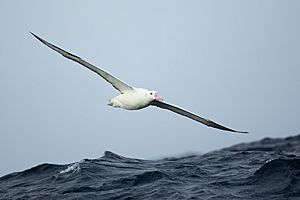Antipodean albatross facts for kids
Quick facts for kids Antipodean albatross |
|
|---|---|
 |
|
| Diomedea antipodensis gibsoni | |
| Conservation status | |
| Scientific classification | |
| Genus: |
Diomedea
|
| Species: |
antipodensis
|
| Subspecies | |
|
Diomedea antipodensis antipodensis Robertson & Warham 1992 |
|
| Synonyms | |
|
Diomedea exulans antipodensis |
|
The Antipodean albatross (Diomedea antipodensis) is a large seabird that belongs to the albatross family. These amazing birds are a bit smaller than wandering albatrosses. They usually have brown feathers when they are breeding. It can be tricky to tell them apart from young wandering albatrosses. Wandering albatrosses get lighter as they get older, but Antipodean albatrosses stay darker.
Contents
What's in a Name?
The name Diomedea antipodensis has two parts. The first part, Diomedea, comes from Diomedes. He was a Greek hero whose friends were said to have turned into birds. The second part, antipodensis, is a Latin word. It refers to the Antipodes Islands, which is where these albatrosses are found.
How Scientists Classify This Albatross
The Antipodean albatross belongs to a group of birds called Procellariiformes. All birds in this group have special tube-like nostrils on their beaks. They also have a unique mouth structure with bony plates.
This albatross is one of the large albatrosses in the Diomedea group. For a long time, it was thought to be just a type of wandering albatross. In 1992, scientists decided it was a different kind of albatross, a subspecies. Then, in 1998, some experts started to call it a full species of its own.
Not all scientists agree on this. But a study in 2004 looked at the birds' DNA. This study supported the idea that the Antipodean albatross should be its own species. Groups like BirdLife International now consider it a separate species.
Different Types of Antipodean Albatrosses
There are two main types, or subspecies, of the Antipodean albatross:
- Diomedea antipodensis antipodensis: This type breeds on the Antipodes Islands and Campbell Island.
- Diomedea antipodensis gibsoni: This type breeds on the Auckland Islands.
What Does the Antipodean Albatross Look Like?
The Antipodean albatross is a big bird, about 110 cm (43 in) long. When they are breeding, their feathers are a mix of brown and white. Young Antipodean albatrosses look a lot like young wandering albatrosses.
Female albatrosses have brown upper parts. They have white wavy lines on their backs. Their face, throat, and belly are white. The feathers under their tail are brown. Their underwings are white with dark tips.
Male albatrosses are whiter than females, but not as white as wandering albatrosses. Both males and females have a pink beak. The females of the antipodensis type have a dark brown band across their chest. The males of this type have a darker head, tail, and shoulder area than the gibsoni type.
Where Do They Live?
| Location | Population | Date | Trend |
|---|---|---|---|
| Antipodes Island | 4,635-5,737 pair | 2007 | Declining |
| Auckland Islands | 5,800 pair | 2007 | Declining |
| Campbell Islands | 10 pair | 2007 | |
| Pitt Island | 1 pair | 2004 | |
| Total | 25,000 | 2007 | Declining |
At sea, Antipodean albatrosses fly across the South Pacific. They can be found from Australia all the way to Chile. Their range goes from the Tropic of Capricorn southwards.
The gibsoni type tends to stay east of Auckland Island. The antipodensis type travels further east, towards Chile. They build their nests and raise their young on the Auckland Islands, Antipodes Islands, and Campbell Island. There has also been one pair breeding on Pitt Island since 2004.
What Do They Do?
Antipodean albatrosses mainly eat cephalopods, like squid and octopus. They also eat some fish. Unlike other albatrosses, they haven't been seen eating crustaceans (like crabs or shrimp). They have been recorded visiting areas where giant cuttlefish lay their eggs off New South Wales.
They build their nests on ridges, slopes, or flat areas. They can build their nests in open spaces or in areas with patches of plants, like tussock grassland.
Helping the Antipodean Albatross
The IUCN says this albatross is an Endangered bird. This means it is at a high risk of becoming extinct. They live across a huge area of 37,400,000 km2 (14,400,000 sq mi) at sea. However, their breeding areas are much smaller, only about 670 km2 (260 sq mi).
In 2007, scientists estimated there were between 4,635 and 5,757 breeding pairs on Antipodes Island. There were about 5,800 pairs on the Auckland Islands (including Adams Island, Auckland Island, and Disappointment Island). Only 10 pairs were found on Campbell Island. This means the total population was around 25,300 birds at that time. Sadly, fewer chicks are surviving (only 25%). Also, fewer adult birds are living each year (80% of females and 88% of males).
Wild pigs and cats on Auckland Island are harming the albatross population. Longline fishing is also a big problem. Albatrosses can get caught on the fishing lines and drown. Recent studies also suggest that warmer ocean temperatures in the Tasman Sea might be affecting the gibsoni type.
Scientists are working hard to help these birds. They are putting bands on the birds' legs to track them. They are also using satellites to follow their movements. Pigs and sheep have been removed from Campbell Island. All the islands where these albatrosses breed are now nature preserves and World Heritage Sites.
To help the albatrosses survive, cats and pigs need to be removed from the Auckland Islands. It's also important to work with fishing companies to make fishing safer for albatrosses. Scientists also need to keep studying how ocean temperature changes affect these birds.
See also
 In Spanish: Albatros de las Antípodas para niños
In Spanish: Albatros de las Antípodas para niños


